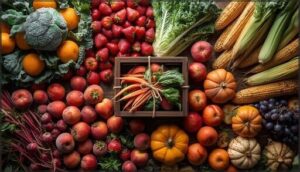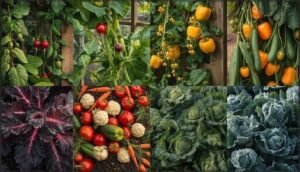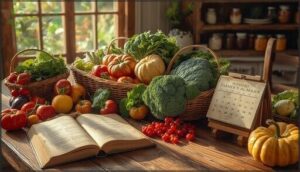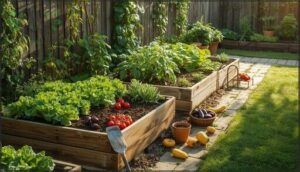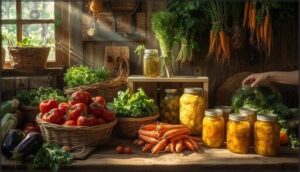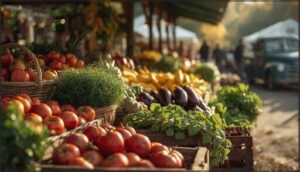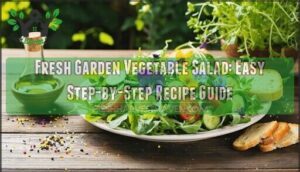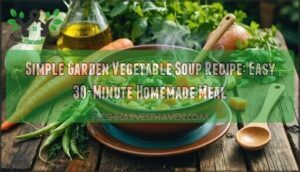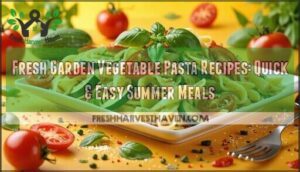This site is supported by our readers. We may earn a commission, at no cost to you, if you purchase through links.
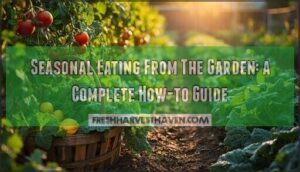
Your summer tomatoes contain up to 30% more vitamins than their winter imports, while fall greens thrive in cool weather that brings out their sweetest flavors. Learning to grow, harvest, and eat what’s actually in season transforms both your plate and your health, one harvest at a time.
Table Of Contents
Key Takeaways
- Eating seasonally from your garden delivers up to 30% more vitamins and minerals than out-of-season imports while cutting grocery costs by an average of $130 per month, as food harvested at peak ripeness retains maximum nutrient density and flavor.
- Growing seasonal crops matched to your climate—cool-season vegetables like kale and spinach in spring and fall, warm-season crops like tomatoes and peppers in summer—reduces your environmental footprint through lower water use (30% less), decreased greenhouse gas emissions, and elimination of long-distance food transportation.
- Proper harvesting techniques like morning picking before temperatures rise and immediate cooling preserve up to 30% more moisture and nutrients, while preservation methods including freezing, canning, and dehydrating extend your harvest 6-12 months with minimal waste.
- You don’t need a large garden to eat seasonally—container gardening, vertical growing systems, farmers’ markets, and CSA programs all provide access to fresh, locally-grown produce that supports community farmers while keeping 80-90 cents of every dollar in your local economy.
Why Eat Seasonally From The Garden
Growing your own food and eating with the seasons isn’t just a trendy idea—it’s a shift that brings real benefits to your health, wallet, and the planet. When you align your meals with what’s naturally ready to harvest, you’re tapping into food at its peak, supporting sustainable practices, and often spending less.
Let’s look at three key reasons why seasonal eating from the garden makes so much sense.
Nutritional and Flavor Benefits
There’s something magical about biting into a sun-warmed tomato straight from your summer garden—the flavor and nutrients are at their absolute peak. When you harvest and eat seasonal food at the right time, you’re getting the most from every bite.
Harvest and eat seasonal food at its peak to get the most flavor and nutrients from every bite
Here’s what you gain from eating seasonally:
- Peak Nutrient Density: In-season produce contains up to 30% more vitamins and minerals than out-of-season varieties, thanks to prime growing conditions.
- Enhanced Flavor Profiles: Naturally ripened crops show up to 35% higher taste scores, with richer aromas and balanced sweetness.
- Reduced Nutrient Loss: Locally harvested produce reaches your plate within 48 hours, preserving up to 90% of initial nutrients.
- Diverse Intake: Seasonal eating exposes you to 75+ unique plant types yearly versus just 20-25 in standard diets.
- Healthier Outcomes: Fresh produce options from your garden support immune resilience and reduce cardiovascular disease risk by up to 25%.
The benefits of seasonal eating go beyond nutrition—every harvest delivers enhanced flavor that transforms ordinary meals into memorable experiences. Eating seasonally also aligns with your metabolic efficiencies developed over time.
Environmental Impact and Sustainability
When you grow food at your own pace with the seasons, you’re making sustainable food choices that genuinely matter for the planet. Seasonal eating from your garden slashes your carbon footprint—in-season crops produce up to three times less greenhouse gas than heated greenhouse alternatives.
You’ll also champion water conservation, using about 30% less water than off-season growing, while boosting soil health through natural composting that cuts landfill waste by half and aids local biodiversity with habitat for pollinators and beneficial insects.
Understanding your USDA plant hardiness zone is essential for successful seasonal gardening.
Cost Savings and Local Economy Support
Beyond the environmental perks, seasonal eating from your garden delivers real financial wins. When produce is in season, you’ll see prices drop by up to 36% at local markets—which matters when the average family spends $331 weekly on groceries. Here’s how your garden grows more than just food:
- Produce Affordability: Peak-season harvests mean lower costs and fresher ingredients that last longer, cutting waste by nearly 40%.
- Farmer Revenue: Buying local produce at farmers markets keeps 80–90 cents of every dollar with small producers instead of big retailers.
- Local Circulation: Each $100 spent on sustainable food through CSAs cycles $62 back into your community—over twice what stays local from grocery chains.
- Economic Resilience: Strengthened local economy ties build food security, creating up to 13 jobs per $1 million in small farm revenue.
Understanding Seasonal Produce Cycles
Understanding what grows when is the foundation of successful seasonal eating. Each month brings different crops to peak ripeness, and knowing these patterns helps you plan meals, shop smarter, and make the most of your garden’s potential.
Let’s break down the seasonal cycles so you can eat fresh all year long.
Identifying What’s in Season Each Month
You don’t need to memorize every harvest date—seasonal databases and crop calendars do the heavy lifting. Apps like SeasonalFoodGuide.org track over 2,000 items by state and month, while USDA guides integrate regional data for better accuracy. Prices drop 25–40% during peak harvest, so knowing your monthly list pays off. Local microclimates shift timing by weeks, making regional availability charts essential for planning your seasonal food strategy.
| Month | Peak Harvest Examples | Key Benefits |
|---|---|---|
| January–February | Citrus, winter greens (kale, collards) | 18% of national produce share; lower prices |
| May–June | Strawberries, cherries, cucumbers, lettuce | 20% of annual berry sales; peak freshness |
| July–August | Tomatoes, corn, peaches, melons | 40% of summer produce sales; abundant local supply |
| September–October | Apples, grapes, pumpkins | 65% of fall farm income; best flavor profiles |
| Year-round | Root vegetables (carrots, beets) | Stable yields; 38% less food waste with local produce |
Common Garden Crops by Season (Spring, Summer, Fall, Winter)
Your planting timeline shapes what lands on your plate. Cool-season crops like peas, spinach, and broccoli tolerate frost and thrive in soil between 45–75°F, making them perfect for spring and fall gardens. Warm-season vegetables—tomatoes, peppers, cucumbers—demand soil above 60°F and full sun during summer months. Winter gardening extends your harvest with kale, carrots, and hardy herbs that survive cold snaps when you use season-extending strategies.
Understanding growing conditions helps you rotate crops, maintain soil health, and plan succession planting for continuous garden produce:
- Spring: Direct-sow peas, radishes, and lettuce outdoors in March–April; start tomatoes and peppers indoors mid-spring for later transplanting
- Summer: Plant heat-loving eggplant, okra, and summer squash after the last frost; these fruit-bearing vegetables need 45–120 days to mature
- Fall/Winter: Seed Brussels sprouts and cauliflower in late summer for fall harvest; protect winter spinach and Asian greens with hoop tunnels for pest control
Matching seed starting dates to your frost calendar maximizes yields and promotes seasonal eating from your own backyard.
Using Seasonal Food Guides for Planning
With seasonal food guides, you can pinpoint what’s ripe in your area each month and tailor meal plans to peak nutrient density.
The USDA Seasonal Produce Guide covers over 40 crops with regional variations across all 50 states, helping you shop farmers markets strategically.
Guide customization slashes grocery bills by 10–25%, cuts waste by 30%, and aids local food sources—all while eating seasonally at its freshest.
Growing a Seasonal Garden at Home
Growing your own seasonal garden puts fresh, flavorful produce right at your fingertips throughout the year. The key is knowing which crops thrive in each season, how to get the most from your plants, and how to protect them when temperatures shift.
Let’s walk through the essentials to help you grow successfully no matter the time of year.
Selecting Crops for Each Season
Your garden’s success starts with matching crops to the season. Cool-season crops like broccoli, kale, and spinach thrive in spring and fall when temperatures hover between 45°F and 75°F. Warm-season crops—tomatoes, peppers, and cucumbers—need soil above 60°F and post-frost planting. Intermediate crops like chard and beets bridge both seasons, producing harvests from April through November.
Regional planting calendars help you time everything right, while crop rotation between leafy greens, fruiting vegetables, and root crops keeps your soil healthy and improves compatibility for growing your own food year-round.
Tips for Maximizing Harvests
Smart crop selection and succession planting can double your garden harvest. Choose high-yielding varieties like tomatoes and zucchini, which score up to 9.0 on efficiency scales. Here’s how to get the most production from your space:
- Succession planting: Stagger bean plantings every 2–3 weeks for 10–12 weeks of continuous harvesting instead of just one month
- Interplanting: Tuck fast-growing radishes between slow-maturing parsnips for double harvests from the same soil
- Vertical growing: Trellis cucumbers and beans to boost yields by 30–50% per square foot
- Soil health: Add compost regularly to increase yields by 21% while improving water retention
- Irrigation optimization: Install drip systems to reduce water use by 30–70% while increasing productivity
These techniques transform growing your own food from a seasonal hobby to year-round abundance, keeping your garden harvest flowing and your table full.
Frost Protection and Extending The Season
Protecting plants from frost damage can turn a six-month growing season into a nine-month harvest window. Row covers increase air temperature by 2–8°C, reducing frost damage by up to 90%. Pair them with these thermal protection strategies:
| Method | Temperature Boost |
|---|---|
| Floating row covers | +2 to 8°C |
| High tunnels | +2.7°C soil protection |
| Water-based irrigation | Stabilizes at 0°C |
Greenhouse technology and caterpillar tunnels extend cucumber and pepper harvests by six weeks. Overhead irrigation releases heat as water freezes, preventing cold damage during critical periods.
These season extension tools get the most out of your gardening window while building cold resistance in your growing system.
Harvesting and Preserving Your Garden Bounty
Once your garden starts producing, knowing when and how to harvest makes all the difference in flavor and nutrition. Getting your bounty from garden to table—or safely stored for later—doesn’t have to be complicated.
Here’s what you need to know about harvesting at the right time and keeping that freshness locked in.
Proper Harvest Techniques for Peak Freshness
Timing your harvest can mean the difference between bland and excellent flavor in your home garden. Early morning picking—before temperatures climb above 20°C—preserves up to 30% more moisture in leafy greens and keeps sugars intact in tomatoes and peppers.
Here’s how to harvest fresh produce at its peak:
- Cut, don’t pull: Use sharp knives or scissors to minimize bruising and extend shelf life by 1–3 days across your vegetable garden
- Watch maturity indicators: Harvest corn when kernels are plump yet tender, and pick snow peas while pods stay flat and dark green
- Cool immediately: Rapid cooling within 30 minutes slows enzymatic breakdown, maintaining vitamins and crispness for days longer in growing vegetables
Smart tool selection and cutting methods protect your kitchen gardening investment while maximizing both yield and quality.
Storage Methods: Refrigeration, GreenBags, Root Cellaring
Once you’ve harvested at peak freshness, smart storage keeps your bounty crisp for months. Your main options—refrigeration, GreenBags, and root cellaring—each suit different crops and timelines.
Refrigeration slows decay by up to 90%, ideal for leafy greens and carrots lasting 2–3 months at 0–2°C. GreenBags absorb ethylene gas, extending shelf life 2–3 times and are reusable 8–10 times. Root cellar design maintains 85–95% humidity and 32–40°F, preserving root crops 6–8 months with zero energy cost—saving you $180–360 annually.
Temperature control matters: most vegetables thrive at 0–2°C, but winter squash needs 10–15°C to avoid chilling injury. Combining methods maximizes storage durability, keeping your pantry staples fresh up to 9 months.
| Method | Best For | Duration |
|---|---|---|
| Refrigeration | Leafy greens, carrots | 1–3 months |
| GreenBags | Peppers, strawberries | +2–4 weeks |
| Root Cellaring | Potatoes, beets, apples | 4–8 months |
Preserving Techniques: Freezing, Canning, Dehydrating With Magic Mill Pro
When storage isn’t enough, preserving garden harvest locks in Freezing Nutrients for months. Freezing is your go-to for Waste Reduction—households practicing it report 25–35% less spoilage. Frozen berries and vegetables retain up to 85% of minerals.
For Canning Safety, pressure-process low-acid foods at 240°F to prevent botulism; high-acid picks need only boiling water.
Dehydrating with the Magic Mill Pro delivers Dehydration Benefits: carrots concentrate to 1,547 kcal/lb, and dehydrated Pantry staples last 6–12 months, cutting packaging waste by 12–18% versus canned goods.
Sourcing and Enjoying Seasonal Foods Locally
Even if your garden’s harvest is winding down, you don’t have to give up on eating seasonally. There are plenty of ways to find fresh, local foods right in your own community.
Here’s how to keep seasonal eating going strong beyond your backyard.
Shopping at Farmers’ Markets and CSAs
Beyond your backyard, Farmers Markets and CSA programs connect you directly with seasonal produce from local farms. These options offer fresh-picked vegetables and fruits at their peak, often harvested just hours before you buy them. When you shop at Farmers Markets or join a CSA farm share, you’re supporting farmers while enjoying produce box selections that inspire seasonal recipes.
Consider these benefits:
- Direct conversations with growers about growing practices and preparation tips
- Access to heirloom varieties unavailable in supermarkets
- Fresher local food that retains more nutrients than shipped alternatives
- Economic impact: each dollar spent generates up to $1.36 in additional local sales
- Community connections that strengthen your relationship with your food source
Market orientation becomes easier as you build relationships with vendors and learn what thrives each season.
Foraging and Pick-Your-Own Opportunities
You can step beyond farm stands into wild edibles through urban foraging and PYO farms. Nearly 45 million people in North America harvest wild food annually, exploring sustainable harvesting in city parks and woodlands.
UPick farms offer strawberries, blueberries, and apples at lower costs while you control freshness.
Always prioritize foraging safety—verify plant identification and avoid contaminated areas before collecting wild food.
Creating Garden-to-Table Meals and Recipes
Turning fresh ingredients into seasonal cuisine starts with planning meals around your harvest calendar. Garden meal planning reduces food waste by up to 37%, while recipes like Swiss chard lasagna and herb-focused meals increase your yield.
Farm-to-table cooking works best when you embrace zero-waste cooking—try carrot-green chimichurri or tomato ratatouille. Culinary garden integration means using healthy options from root vegetables to fresh rosemary year-round through strategic preservation.
Seasonal recipe design becomes second nature once you match crops to dishes.
Frequently Asked Questions (FAQs)
How do you meal plan around garden harvests?
Lettuce talk planning: check your kitchen garden weekly, noting what’s ready, then build garden-inspired menus around peak harvests.
Match recipe timing to food availability, use seasonal substitutions for missing items, and embrace harvest meal balance to boost nutrients while reducing waste from garden-fresh seasonal foods.
What if my garden produces too much at once?
When your kitchen garden overflows, you’ve reached the ideal point of gardening. Preserve surplus through freezing, canning, or dehydrating.
Share garden-fresh produce with neighbors, donate to food banks, or swap with CSA members.
Try creative recipes that use abundance wisely, transforming harvest into extended storage solutions.
How do you start gardening with limited space?
You can grow plenty of food in tight quarters with vertical gardening systems, container selection, and balcony gardens that stretch space.
Can you eat seasonally without a garden?
You don’t need a garden to embrace seasonal eating. Farmers markets and CSA boxes connect you directly with local food sources, bypassing lengthy food supply chains. Your local grocery store often highlights seasonal food from nearby farms.
Preserved foods extend seasonal flavors year-round through canning and freezing. While foraging offers adventure, foraging risks require careful identification skills.
Farmers market benefits include fresher produce, local sourcing, and supporting your community’s growers.
What are beginner-friendly crops for seasonal gardening?
Start where you’re, use what you have”—and that’s exactly what makes Easy Spring Crops like lettuce, radishes, and herbs perfect for beginners in your kitchen garden.
Simple Summer Plants such as tomatoes and zucchini thrive with minimal care, while Fall Harvest Options including carrots and kale endure cooler weather beautifully.
Conclusion
Imagine paying full price for wilted imports while your backyard sits empty—it’s like owning a gold mine and shopping at the dollar store. Seasonal eating from the garden flips that script entirely.
You’ve walked through the why, the when, and the how of growing and preserving what thrives naturally in your climate. Now it’s just a matter of getting your hands dirty, watching your first seedlings break ground, and tasting the difference that real freshness makes.
Your garden’s waiting, and so is that grocery savings your neighbor can’t stop talking about.
- https://pubmed.ncbi.nlm.nih.gov/37215644/
- https://pmc.ncbi.nlm.nih.gov/articles/PMC10196338/
- https://foodmedcenter.org/sustainable-farming-nutrient-density/
- https://www.bryceenergyservices.com/2024/11/21/seasonal-foods-the-pros-and-cons-of-eating-seasonally/
- https://www.cnn.com/2022/09/14/health/seasonal-food-produce-lbg-wellness

